You are using an out of date browser. It may not display this or other websites correctly.
You should upgrade or use an alternative browser.
You should upgrade or use an alternative browser.
[Game] Forgotten Hope 2
- Thread starter Ts4EVER
- Start date
Hello and welcome back to another update of Forgotten Hope 2!
As promised in the last news update on Friday, we have some nice Eastern Front teasers for you.
The first one is a heavy German tank destroyer which, while rare and relatively unsuccessful, left its mark on the Kursk offensive: The Panzerj
As promised in the last news update on Friday, we have some nice Eastern Front teasers for you.
The first one is a heavy German tank destroyer which, while rare and relatively unsuccessful, left its mark on the Kursk offensive: The Panzerj
Upvote
0
Hello and welcome back to another update of Forgotten Hope 2!
As promised in the last news update on Friday, we have some nice Eastern Front teasers for you.
The first one is a heavy German tank destroyer which, while rare and relatively unsuccessful, left its mark on the Kursk offensive: The Panzerj
Upvote
0
Devblog by knoffhoff
The road to Prokhorovka Part 3: getting at it again
When building a map it is very likely that at one point your work is being halted for some time.
In this case due to several reasons I even did not work on the map for more than 3 months.
In mid December I slowly started to get into the project again and am hoping to be developing at full speed sometime soon.
Since the basic setup was more or less done, I decided to place some tanks on the map and as I'm sure some of you have witnessed, have a first playtest.
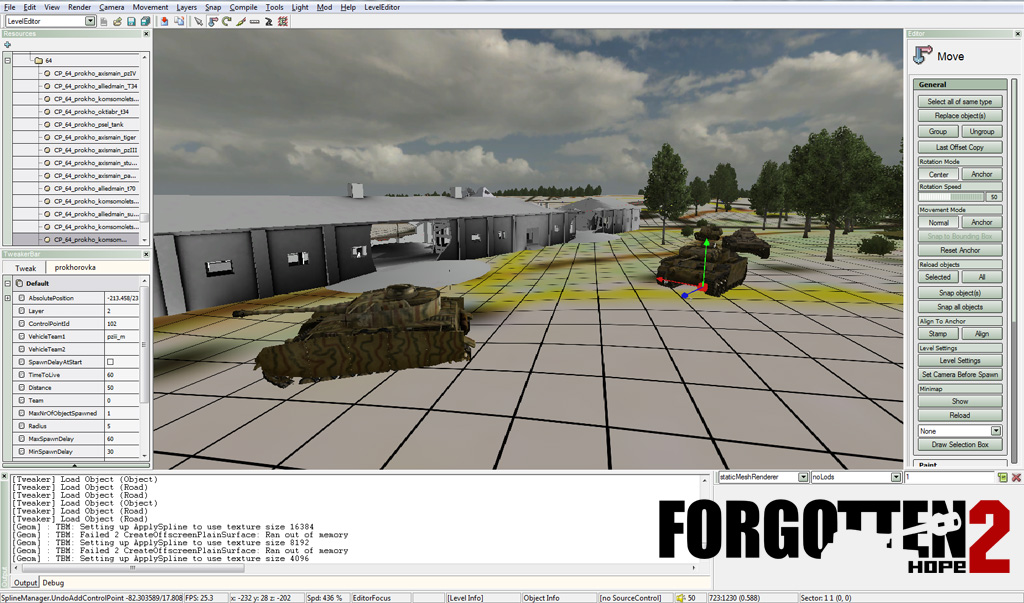
The goal of this playtest was to find out where exactly I have to do improvements in the maps composition to make tank combat as interesting as possible. As you can see on the minimap the map in the current state was rather plain, so there is plenty of room to do terrain modifications, place statics and overgrowth to ensure that tank fighting works.
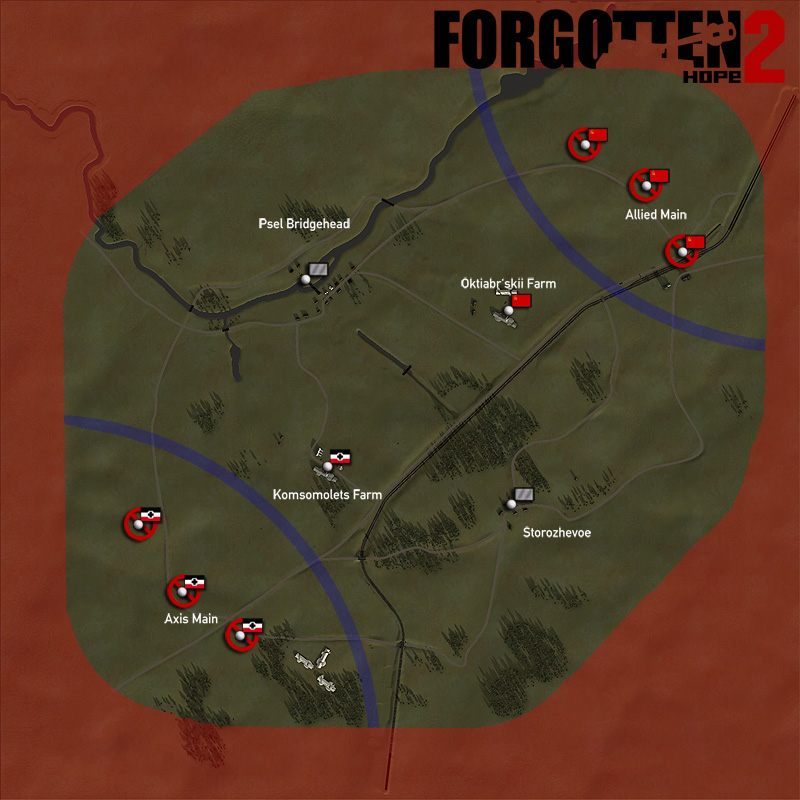
One thing I realized pretty fast was that the routes to the flags needed to be altered.
With building new roads using the road and apply spline tool I try to make sure that important sections of those roads are better positioned on the map and also ensure that both teams have suitable routes to the flags.

Another thing to improve routes to the flag area is providing more cover, which can be done by changing the terrain, but in the rather flat river area of the map is mostly done with placing objects and overgrowth. For now all object and overgrowth placement is still makeshift and only has the role to be there and give me a better image of how the map is going to play out later.

While being at changing terrain features to a higher detail level I also for the first time started to think about on how to implemet my ideas of how the map is supposed to look. For now this is kept to a rather low level and is limited to creating flat terrain right next to the river that will later have a swampy look and is covered with reed or similar plants that grwow under such conditions.
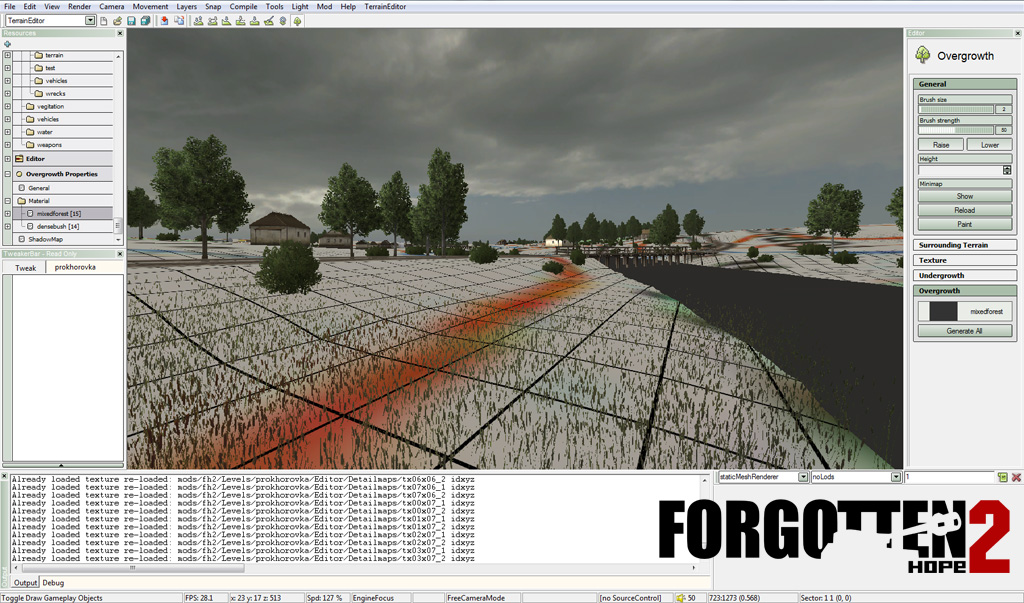
That's it for today. Thanks for your patience and I'm hoping to be able to post here more frequently again.
Upvote
0
Hello and welcome back to another Forgotten Hope 2 update.
We'd like to take this opportunity to wish everyone of our loyal fans a happy new year. To start off 2013, we have a render of perhaps a lesser known Soviet tank: the T-70 light tank.

Even as early as 1942 the Soviets considered light tanks to be obsolete, especially compared to the T-34. However, light tanks had the advantage that they could be constructed in small factories that were unable to manage with the larger medium and heavy tanks. In 1942 the T-70 was introduced to replace both the obsolete T-60 reconnaissance tank and the complicated and expensive T-50 light infantry tank.
The first T-70s to roll off the production line were fitted with two engines, each of which powered one track. This was not an ideal setup, and the tank was soon modified to the T-70M with both engines mounted on the right and working together. The turret was also simplified and the mounting moved to the left hand side.
One big drawback of its design was its cramped turret, which was only big enough for one crew member. A version with a bigger turret was produced as the T-80 starting in 1943, but by that time there was enough lend-lease mat
We'd like to take this opportunity to wish everyone of our loyal fans a happy new year. To start off 2013, we have a render of perhaps a lesser known Soviet tank: the T-70 light tank.

Even as early as 1942 the Soviets considered light tanks to be obsolete, especially compared to the T-34. However, light tanks had the advantage that they could be constructed in small factories that were unable to manage with the larger medium and heavy tanks. In 1942 the T-70 was introduced to replace both the obsolete T-60 reconnaissance tank and the complicated and expensive T-50 light infantry tank.
The first T-70s to roll off the production line were fitted with two engines, each of which powered one track. This was not an ideal setup, and the tank was soon modified to the T-70M with both engines mounted on the right and working together. The turret was also simplified and the mounting moved to the left hand side.
One big drawback of its design was its cramped turret, which was only big enough for one crew member. A version with a bigger turret was produced as the T-80 starting in 1943, but by that time there was enough lend-lease mat
Upvote
0
Just played some FH2 for the first time in a couple months! Epic, especially on the 128 player server. Totally satisfies my WWII epic battle needs.
Upvote
0
Forgotten Honor Proudly Presents
PRONE TO STORMS
A brand new Forgotten Hope 2 campaign now open!

2nd New Zealand Division vs 25th Panzer-Grenadier Division


MAKE YOUR CHOICE!
With this brand new Forgotten Honor campaign, Prone to Storms, you will experience:
PRONE TO STORMS
A brand new Forgotten Hope 2 campaign now open!

After successfully concluding 2012 with our first joint tournament, we are going to start 2013 with a classic F|H tournament.
This time we will take you from the mountains of Greece, to the hot deserts of North Africa and bloody engagements over Italy and France.
Climb mountains and stand your ground in challenging infantry actions as an infantry soldier.
Cook eggs on the sizzling engine decks of your tank and hit the enemy line in force as a tank crewman.
Enjoy the fresh air and rain destruction from the sky as a pilot.
Support your team by wreaking havoc in the enemy lines with your barrages as an artillery operator.
This campaign will have you experience all the gigantic fighting for the Mediterranean.
The maps that will be played in this twelve battle, action packed campaign include specially made maps for the Forgotten Honor community... Experience World War II fighting from the comfort of your home:
Corinth Canal, Invasion of Cyclades, Sollum, Etna Line, Battle of Ortona and the epic Operation Epsom... we have the lot! In the ONE, single, most intense campaign so far... You don't want to miss it, be a part of it, make it happen.
Will you join the 2nd New Zealand Division of the daring British Army, or the 25th Panzer-Grenadier Division of the mighty Wehrmacht?
This time we will take you from the mountains of Greece, to the hot deserts of North Africa and bloody engagements over Italy and France.
Climb mountains and stand your ground in challenging infantry actions as an infantry soldier.
Cook eggs on the sizzling engine decks of your tank and hit the enemy line in force as a tank crewman.
Enjoy the fresh air and rain destruction from the sky as a pilot.
Support your team by wreaking havoc in the enemy lines with your barrages as an artillery operator.
This campaign will have you experience all the gigantic fighting for the Mediterranean.
The maps that will be played in this twelve battle, action packed campaign include specially made maps for the Forgotten Honor community... Experience World War II fighting from the comfort of your home:
Corinth Canal, Invasion of Cyclades, Sollum, Etna Line, Battle of Ortona and the epic Operation Epsom... we have the lot! In the ONE, single, most intense campaign so far... You don't want to miss it, be a part of it, make it happen.
Will you join the 2nd New Zealand Division of the daring British Army, or the 25th Panzer-Grenadier Division of the mighty Wehrmacht?
2nd New Zealand Division vs 25th Panzer-Grenadier Division
MAKE YOUR CHOICE!
With this brand new Forgotten Honor campaign, Prone to Storms, you will experience:
Last edited:
Upvote
0
Join the Allies for Victory!

Click the link below to join
http://forgottenhonor.com/modules.php?name=Register&tourney=7
We present you our experienced officers
that will lead the Allied side to success in the battelfield!
[2NZ] 2nd New Zealand Division


Lieutenant General
ikhoppa2

Major General
RAnDOOm

Brigadier
Surfbird
28th Maori Battalion


Captain
ville

Lieutenant
liam70000

2nd Lieutenant
SniperWiesel
27th Machine Gun Battalion


Captain
Maxa

Lieutenant
Gr1zu
Northumberland Hussars Tank Regiment


Captain
Beyers

Lieutenant
DanielNL

2nd Lieutenant
JoenM
22nd Infantry Battalion


Captain
beavis_aka_ostwind

Lieutenant
theUg

2nd Lieutenant
Slepov92
Join the Allies for Victory!
Upvote
0
Look at all those fancy badges, just like the Russian generals. The more the merrier right?
Signups are open and the campaign starts this week.
You can join and experience WW2 with 50x50 player battles with tank/air/sea/infantry combat.
Upvote
0
Hello and welcome back to another Forgotten Hope 2 update.
Today we have an announcement from Forgotten Honor as well as a couple of renders of an important Soviet assault gun, the SU-76 (also known as the SU-12) and it's more successful derivative, the SU-76M.

At the start of the war, the Red Army could call on only a handful of self-propelled guns for infantry support and tank destroying. In late 1942, orders were given for a light self-propelled gun armed with the 76.2 mm Divisional Gun ZiS-3. The winning design was Factory 38's SU-12. This used a lengthened version of the T-70's hull, fitted with an enclosed or canvas roofed case-mate at the rear.
The SU-76 had the same twin engine setup as the early T-70, and the problems this caused were severe enough that production was halted after just 350 had been made. The update to the SU-76M took about 3 months, and involved moving the two engines over to the righthand side of the hull, and lowering the armour protection at the rear. This later change led to the nickname 'bare-arsed Ferdinand', and made the crew extremely vulnerable.
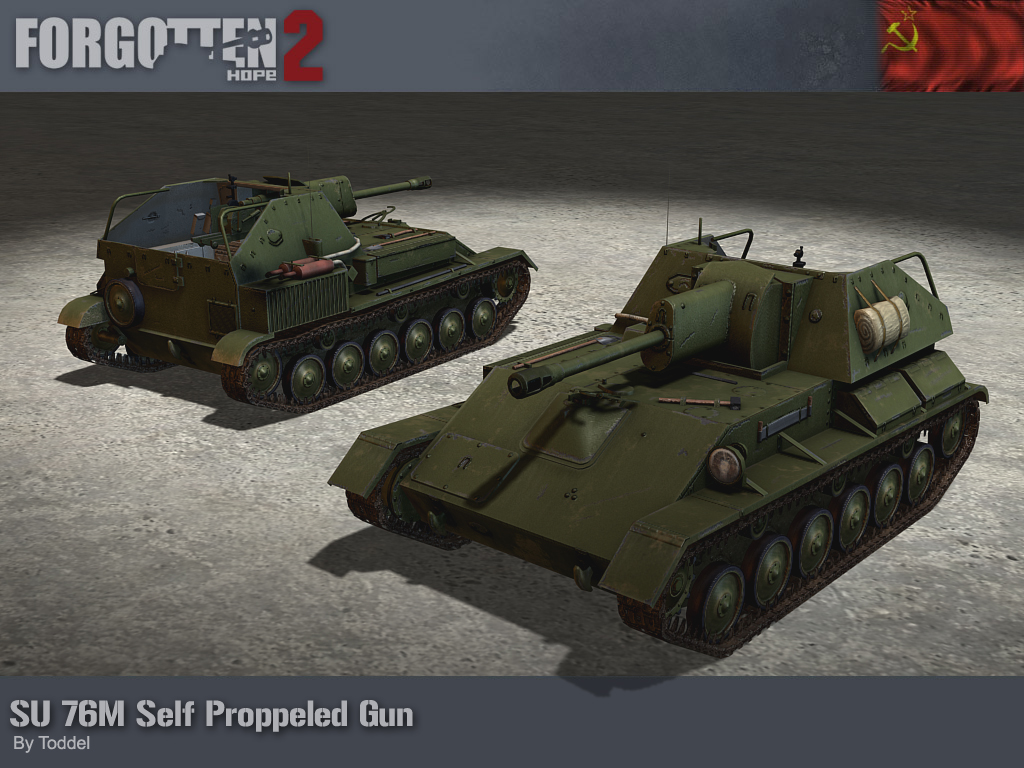
The SU-76M replaced almost all the infantry tanks in the Red Army. It had such a low ground pressure that it could follow infantry through swamps no other vehicle could, and the large cannon and ease of communication between the crew and supporting infantry made it effective in urban environments too. Both our SU-76 and Su-76M were made by Toddel.
Today we have an announcement from Forgotten Honor as well as a couple of renders of an important Soviet assault gun, the SU-76 (also known as the SU-12) and it's more successful derivative, the SU-76M.

At the start of the war, the Red Army could call on only a handful of self-propelled guns for infantry support and tank destroying. In late 1942, orders were given for a light self-propelled gun armed with the 76.2 mm Divisional Gun ZiS-3. The winning design was Factory 38's SU-12. This used a lengthened version of the T-70's hull, fitted with an enclosed or canvas roofed case-mate at the rear.
The SU-76 had the same twin engine setup as the early T-70, and the problems this caused were severe enough that production was halted after just 350 had been made. The update to the SU-76M took about 3 months, and involved moving the two engines over to the righthand side of the hull, and lowering the armour protection at the rear. This later change led to the nickname 'bare-arsed Ferdinand', and made the crew extremely vulnerable.

The SU-76M replaced almost all the infantry tanks in the Red Army. It had such a low ground pressure that it could follow infantry through swamps no other vehicle could, and the large cannon and ease of communication between the crew and supporting infantry made it effective in urban environments too. Both our SU-76 and Su-76M were made by Toddel.
Upvote
0
vHello and welcome back to another Forgotten Hope 2 update.
Today we have two of renders featuring some equipment that you are sure to find useful on the battlefield.
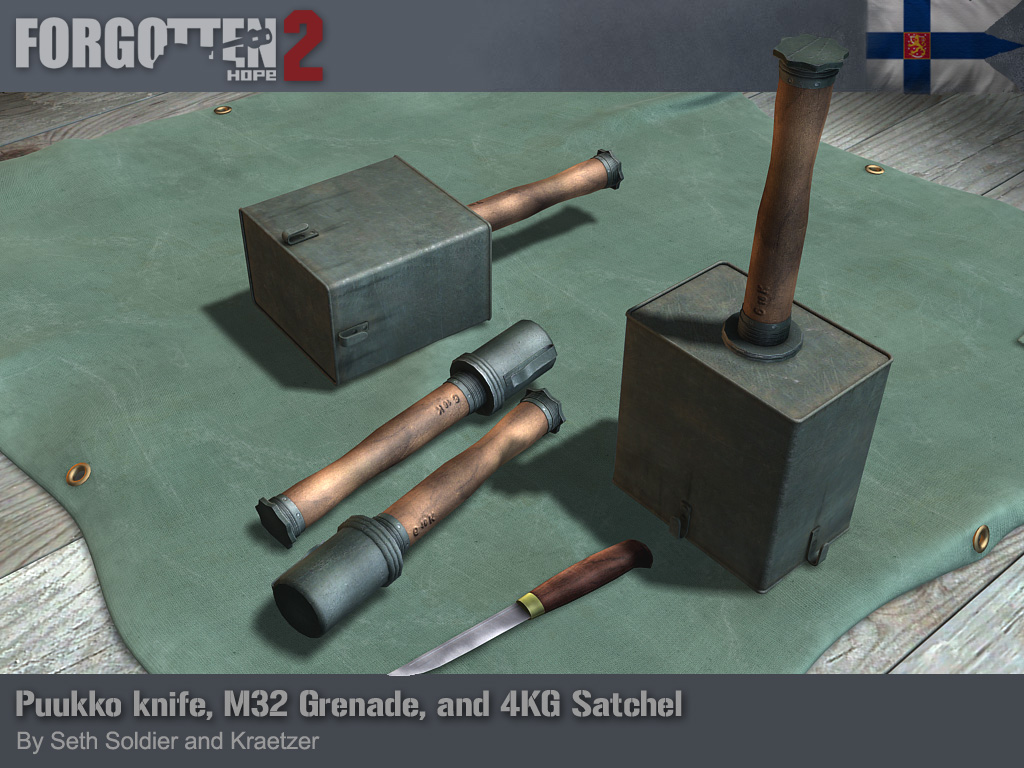
The puukko is a type of small cutting knife that is traditionally carried by the Finnish. Designed for everyday tasks such as wood carving and the preparation of caught fish and game, the knife has also found much use in the various wars fought by the Finnish army. This diminutive but deadly knife was made by Seth Soldier.
The M32 stick grenade is an offensive hand grenade very similar in design to the German M24 grenade. The main differences were the use of an impact fuse instead of the German friction igniter, the design retained the belt-hook of older German grenade designs, and that the M32 is shorter than the M24.
The Finnish were aware of the German tactic of wiring extra heads to their grenades to make powerful anti-tank grenades, and decided that they needed a custom made design. While many designs were made in the field, there were also factory made weapons. These were 2, 3 and 4 kg charges using M32 and M24 stick grenade fuses, and were effective against most Soviet armoured vehicles.
The M32 grenade was made by Seth Soldier and modified into a 4 kg satchel charge by Kraetzer.
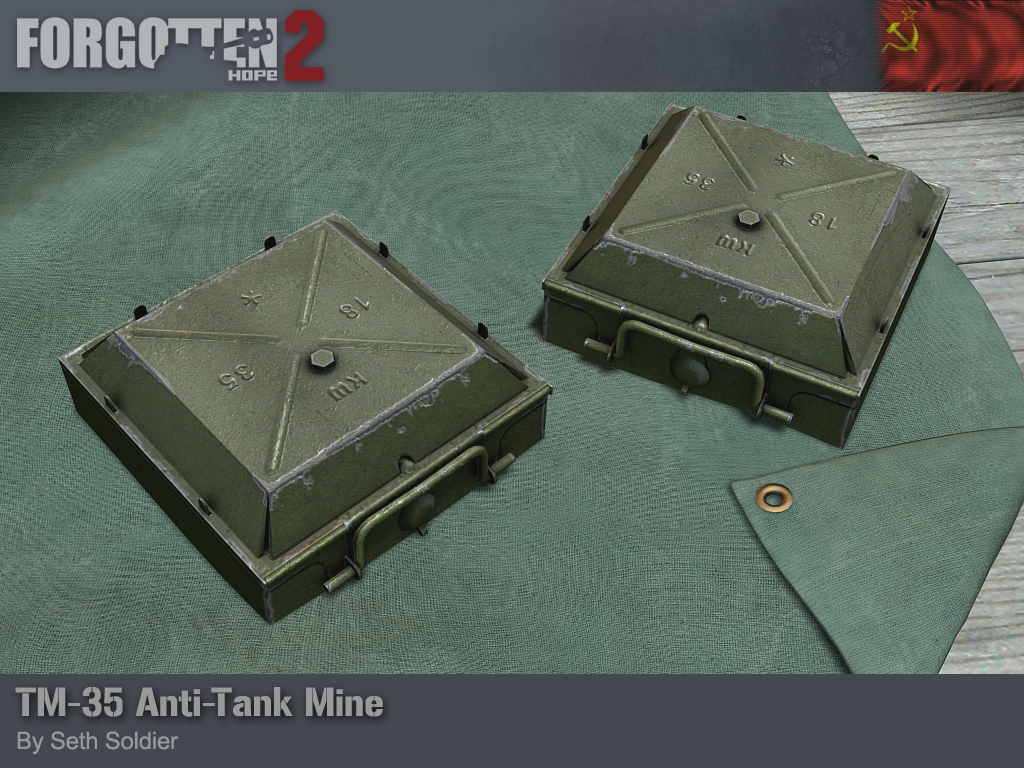
The TM-35 was a Soviet anti-tank mine used on the Eastern Front. It was a simple square metal box that could contain up to 2.8 kg of explosives. A tank driving over the mine pressed down on the top plate, which removed a pin from the firing mechanism via a simple seesaw action. This mine was made by Seth Soldier.
Today we have two of renders featuring some equipment that you are sure to find useful on the battlefield.

The puukko is a type of small cutting knife that is traditionally carried by the Finnish. Designed for everyday tasks such as wood carving and the preparation of caught fish and game, the knife has also found much use in the various wars fought by the Finnish army. This diminutive but deadly knife was made by Seth Soldier.
The M32 stick grenade is an offensive hand grenade very similar in design to the German M24 grenade. The main differences were the use of an impact fuse instead of the German friction igniter, the design retained the belt-hook of older German grenade designs, and that the M32 is shorter than the M24.
The Finnish were aware of the German tactic of wiring extra heads to their grenades to make powerful anti-tank grenades, and decided that they needed a custom made design. While many designs were made in the field, there were also factory made weapons. These were 2, 3 and 4 kg charges using M32 and M24 stick grenade fuses, and were effective against most Soviet armoured vehicles.
The M32 grenade was made by Seth Soldier and modified into a 4 kg satchel charge by Kraetzer.

The TM-35 was a Soviet anti-tank mine used on the Eastern Front. It was a simple square metal box that could contain up to 2.8 kg of explosives. A tank driving over the mine pressed down on the top plate, which removed a pin from the firing mechanism via a simple seesaw action. This mine was made by Seth Soldier.
Upvote
0
Guna try this, although it's probably a few years too late.
At the time of me writing this there are 49 players online, I'd expect that number to rise as the evening progresses. Other than that you could wait for the next patch, the servers are always full on release week and the months after that.
Upvote
0
Hello and welcome back to another Forgotten Hope 2 update.
Today we have a render of one of the many rifles used by the Finnish soldier throughout the Second World War: the M/39 "Ukko-Pekka"

Following independence from Russia, Finland had been left with many thousands of M1891 Mosin Nagants, and rather than develop entirely new weapons, simply adapted these weapons for their own use. The desire to develop improvements on the original design, and differing ideas on what should be included, led to the Army's M/27 and the Civil Guard's M/28-30 rifles.
By the mid 30's, the Army had realised that many of its M/27 were poorly made, and that a newer rifle was needed. They were, however, unwilling to adopt the M/28-30, and called for the development of a newer weapon. An attempt was made with the M/91-35, but this proved to be too inaccurate. Eventually, it was decide to base the new rifle on the M/28-30. The final design of the new M/39 was completed by February 1939, but the outbreak of the Winter War delayed production such that the Army only started to receive them in 1941.
The nickname "Ukko-Pekka" was derived from former president Pehr Evind Svinhufvud, and means "Old Man Pete." The M/39 rifle was made by Seth Soldier.
Today we have a render of one of the many rifles used by the Finnish soldier throughout the Second World War: the M/39 "Ukko-Pekka"

Following independence from Russia, Finland had been left with many thousands of M1891 Mosin Nagants, and rather than develop entirely new weapons, simply adapted these weapons for their own use. The desire to develop improvements on the original design, and differing ideas on what should be included, led to the Army's M/27 and the Civil Guard's M/28-30 rifles.
By the mid 30's, the Army had realised that many of its M/27 were poorly made, and that a newer rifle was needed. They were, however, unwilling to adopt the M/28-30, and called for the development of a newer weapon. An attempt was made with the M/91-35, but this proved to be too inaccurate. Eventually, it was decide to base the new rifle on the M/28-30. The final design of the new M/39 was completed by February 1939, but the outbreak of the Winter War delayed production such that the Army only started to receive them in 1941.
The nickname "Ukko-Pekka" was derived from former president Pehr Evind Svinhufvud, and means "Old Man Pete." The M/39 rifle was made by Seth Soldier.
Upvote
0
Hello and welcome back to another Forgotten Hope 2 update.
Today we have another render of another Finnish weapon, the Lahti-Saloranta M/26.
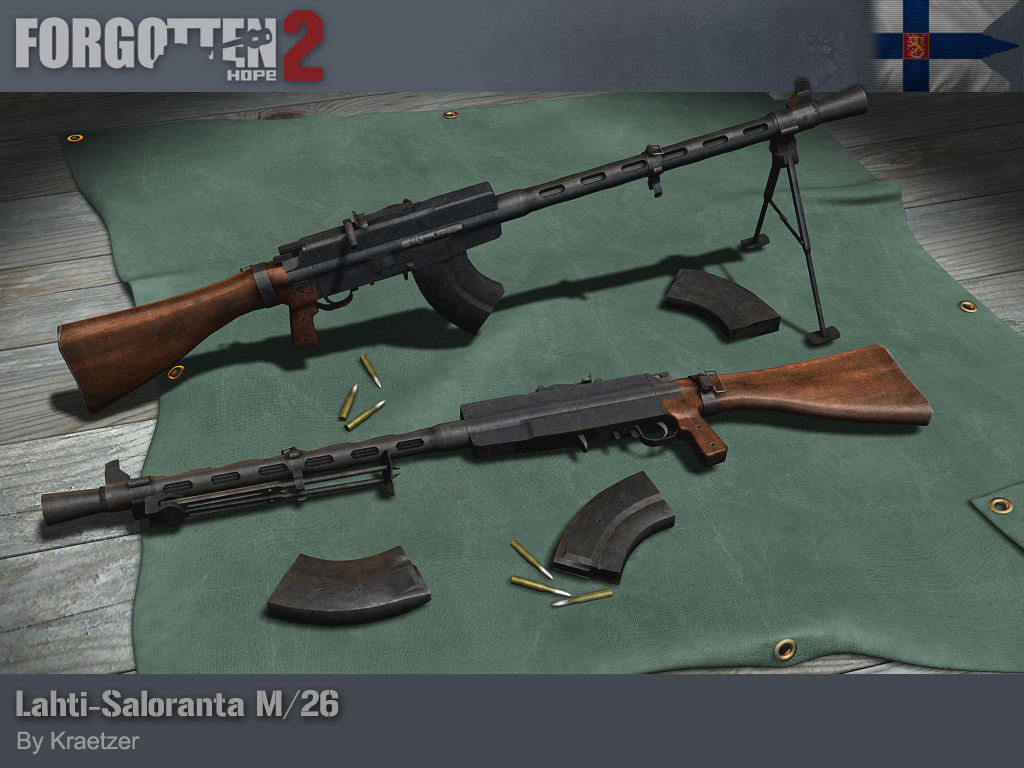
The M/26 started life when Aimo Lahti was looking for things to do following his design of the Suomi KP/31 prototype. When the Finnish Army put out a request for designs for a new light machinegun, Lahti's design was one of those that was considered. Since Lahti had no formal engineering experience, Lieutenant Arvo Saloranta was appointed to assist him.
After acceptance, there were almost constant issues surrounding the weapon. Saloranta had made unauthorised modifications to the accepted designs, causing production delays and his removal from the project. The weapon itself would jam constantly due to weak extractors and low quality magazine springs. It was also very heavy and had a very strong recoil, and the 20 round magazines were too small.
These issues meant that it received the nickname "Kootut virheet" meaning "assorted mistakes" from the soldiers who used it. Its only redeeming feature over the captured Degtyarevs was that it was more accurate. About 5000 were produced between 1927 and 1942, and by 1944, there were nearly three times as many captured Degtyarevs in use at the front than Lahti-Salorantas. The M/26 was made by Kraetzer.
Today we have another render of another Finnish weapon, the Lahti-Saloranta M/26.

The M/26 started life when Aimo Lahti was looking for things to do following his design of the Suomi KP/31 prototype. When the Finnish Army put out a request for designs for a new light machinegun, Lahti's design was one of those that was considered. Since Lahti had no formal engineering experience, Lieutenant Arvo Saloranta was appointed to assist him.
After acceptance, there were almost constant issues surrounding the weapon. Saloranta had made unauthorised modifications to the accepted designs, causing production delays and his removal from the project. The weapon itself would jam constantly due to weak extractors and low quality magazine springs. It was also very heavy and had a very strong recoil, and the 20 round magazines were too small.
These issues meant that it received the nickname "Kootut virheet" meaning "assorted mistakes" from the soldiers who used it. Its only redeeming feature over the captured Degtyarevs was that it was more accurate. About 5000 were produced between 1927 and 1942, and by 1944, there were nearly three times as many captured Degtyarevs in use at the front than Lahti-Salorantas. The M/26 was made by Kraetzer.
Upvote
0
Hello and welcome back to another Forgotten Hope 2 update.
Today we have a render of the Finnish Suomi KP/-31 submachinegun, as well as a quick announcement from the World at War tournament.
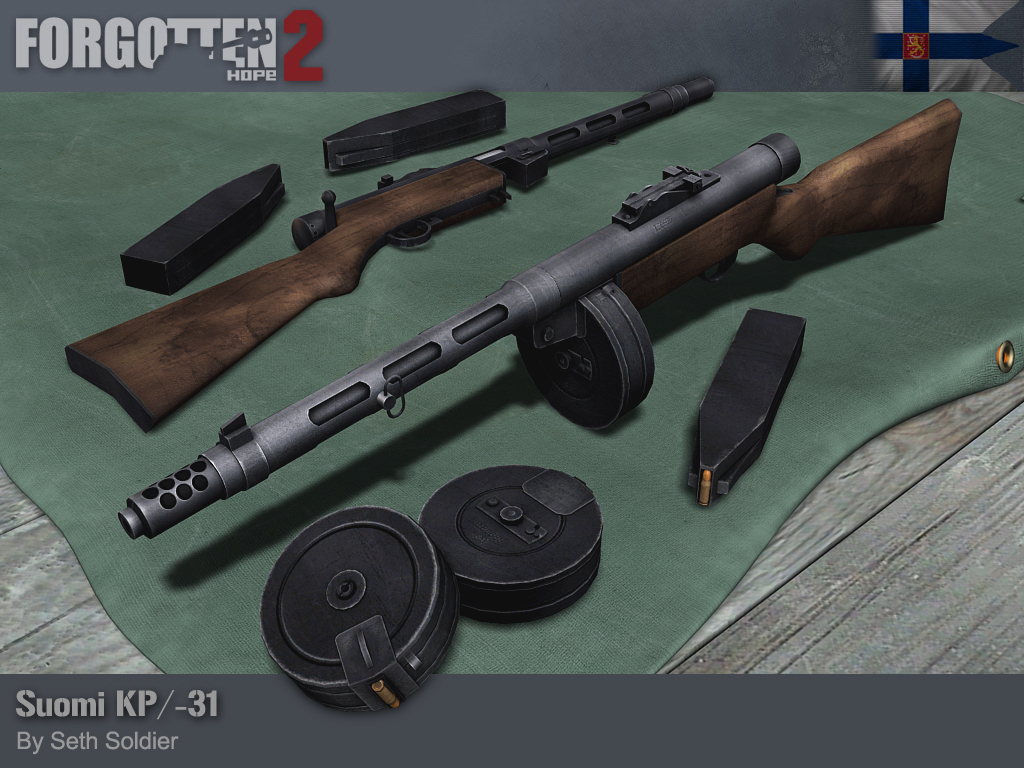
In 1921 Aimo Lahti had taken it upon himself to design a cheaper alternative to the Bergmann M/20. The Army showed some interest in the designs and placed orders for a small number. What would later be called the KP/-26 had several problems, and the KP/-31 was Lahti's answer to these faults.
The KP/-31 was a reliable and accurate, if somewhat heavy weapon. The long barrel and low recoil gave it a longer effective range than other submachineguns of the time. Somewhat unusually, the barrel and shroud were easy to remove and switch with a spare, useful for a weapon with such a high rate of fire. The original magazines were somewhat problematic: the 20 round box was too small and the 40 round drum was heavy and hard to fill. These were gradually replaced by a larger capacity 70 round drum and the rarer 50 round "coffin" box magazines.
After February 1943, the KP/-31 was fitted with a large muzzle brake to counteract muzzle climb, and this can be seen on our model. Approximately 50,000 KP/-31s were manufactured for Finland, of which about half had the SJR muzzle brake. There were also 2 variants: 500 weapons modified for use in bunkers, and 40 four use as hull guns in Vickers 6-ton tanks. Our KP/-31 was made by Seth Soldier.
Today we have a render of the Finnish Suomi KP/-31 submachinegun, as well as a quick announcement from the World at War tournament.

In 1921 Aimo Lahti had taken it upon himself to design a cheaper alternative to the Bergmann M/20. The Army showed some interest in the designs and placed orders for a small number. What would later be called the KP/-26 had several problems, and the KP/-31 was Lahti's answer to these faults.
The KP/-31 was a reliable and accurate, if somewhat heavy weapon. The long barrel and low recoil gave it a longer effective range than other submachineguns of the time. Somewhat unusually, the barrel and shroud were easy to remove and switch with a spare, useful for a weapon with such a high rate of fire. The original magazines were somewhat problematic: the 20 round box was too small and the 40 round drum was heavy and hard to fill. These were gradually replaced by a larger capacity 70 round drum and the rarer 50 round "coffin" box magazines.
After February 1943, the KP/-31 was fitted with a large muzzle brake to counteract muzzle climb, and this can be seen on our model. Approximately 50,000 KP/-31s were manufactured for Finland, of which about half had the SJR muzzle brake. There were also 2 variants: 500 weapons modified for use in bunkers, and 40 four use as hull guns in Vickers 6-ton tanks. Our KP/-31 was made by Seth Soldier.
Upvote
0
Hello and welcome back to another Forgotten Hope 2 update.
Today we are showing off a render of the most well know Soviet artillery piece: the BM-13 "Katyusha".

In mid 1938, the Jet Propulsion Research Institute of Leningrad was ordered to develop a mobile mount for the launching of multiple RS-132 aircraft rockets. The eventual winning design consisted of 16 launch rails attached to a simple frame that could be moved to aim at the target. The nickname "Katyusha" came from a popular wartime song of the same title.
Initially shunned by the artillery branch because of their long reload time and low sustained fire rate, they were ordered into mass production following successful combat trials. While not as accurate as normal artillery, the launchers had several advantages. The noise and effect caused fear amongst the German's, who knew the weapon as "Stalin's Organ". They were also cheaper to make and required less complex machinery than howitzers.
The BM-13, and its derivatives the smaller BM-8 and larger BM-30 were mounted on a wide variety of trucks and in a wide variety sizes. Initially, ZiS-5 and ZiS-6 trucks were favoured, but the BM-13 design was soon standardised onto the newly available Lend-Lease Studebaker US6. Our Katyusha and Studebaker were made by Toddel.
Today we are showing off a render of the most well know Soviet artillery piece: the BM-13 "Katyusha".

In mid 1938, the Jet Propulsion Research Institute of Leningrad was ordered to develop a mobile mount for the launching of multiple RS-132 aircraft rockets. The eventual winning design consisted of 16 launch rails attached to a simple frame that could be moved to aim at the target. The nickname "Katyusha" came from a popular wartime song of the same title.
Initially shunned by the artillery branch because of their long reload time and low sustained fire rate, they were ordered into mass production following successful combat trials. While not as accurate as normal artillery, the launchers had several advantages. The noise and effect caused fear amongst the German's, who knew the weapon as "Stalin's Organ". They were also cheaper to make and required less complex machinery than howitzers.
The BM-13, and its derivatives the smaller BM-8 and larger BM-30 were mounted on a wide variety of trucks and in a wide variety sizes. Initially, ZiS-5 and ZiS-6 trucks were favoured, but the BM-13 design was soon standardised onto the newly available Lend-Lease Studebaker US6. Our Katyusha and Studebaker were made by Toddel.
Upvote
0
Hello and welcome back to another Forgotten Hope 2 update.
Today we have a render of one of the most produced aircraft of all time, the Polikarpov Po-2.
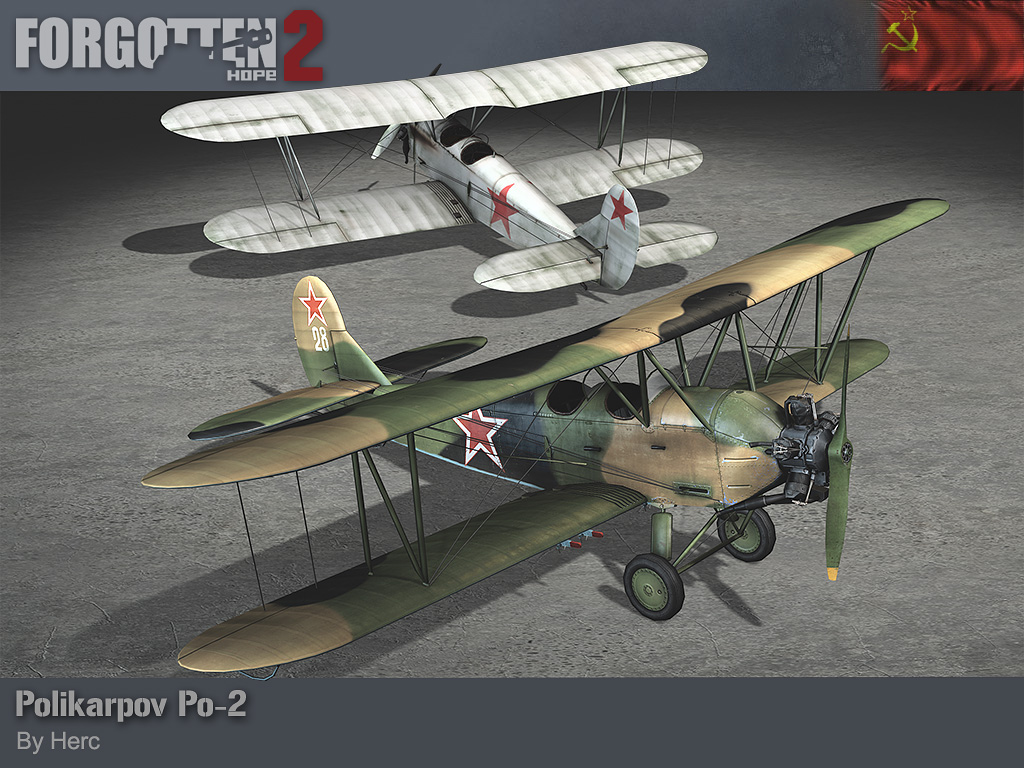
Originally known as the U-2, the aircraft was designed in the late 1920s by Nikolai Polikarpov as a replacement for the U-1. It saw extensive use by civilians and the military. Its application as a crop duster gave it the nickname Kukuruznik, derived from the word for maize. At the start of the war, the Soviet Air Force was using the Po-2 for all kinds of work, including liaison, medivac, reconnaissance and general supply.
Its most famous use was as a night bomber. With a machinegun added to the observer's cockpit and space for up to 350 kg of bombs or RS-82 rockets beneath the wings, it was used in daring low level attacks. The distinctive engine sound, and the near silence of the gliding bombing runs in the dead of night gave these missions a psychological effect in excess of any material damage caused. Perhaps the most notorious pilots were the all female 588th Night Bomber Regiment - the so called Night Witches.
The Po-2 was hard to detect, and a challenging target for fighters to shoot down. Its simple construction could absorb many hits with little effect, the pilots flew incredibly low to the ground, and it was so slow compared to Bf 109 and Fw 190 fighters that keeping on target for any decent length of time was nearly impossible. Between 30 and 40 thousand Po-2 were assembled between 1928 and 1959, and our one was made by Herc.
Today we have a render of one of the most produced aircraft of all time, the Polikarpov Po-2.

Originally known as the U-2, the aircraft was designed in the late 1920s by Nikolai Polikarpov as a replacement for the U-1. It saw extensive use by civilians and the military. Its application as a crop duster gave it the nickname Kukuruznik, derived from the word for maize. At the start of the war, the Soviet Air Force was using the Po-2 for all kinds of work, including liaison, medivac, reconnaissance and general supply.
Its most famous use was as a night bomber. With a machinegun added to the observer's cockpit and space for up to 350 kg of bombs or RS-82 rockets beneath the wings, it was used in daring low level attacks. The distinctive engine sound, and the near silence of the gliding bombing runs in the dead of night gave these missions a psychological effect in excess of any material damage caused. Perhaps the most notorious pilots were the all female 588th Night Bomber Regiment - the so called Night Witches.
The Po-2 was hard to detect, and a challenging target for fighters to shoot down. Its simple construction could absorb many hits with little effect, the pilots flew incredibly low to the ground, and it was so slow compared to Bf 109 and Fw 190 fighters that keeping on target for any decent length of time was nearly impossible. Between 30 and 40 thousand Po-2 were assembled between 1928 and 1959, and our one was made by Herc.
Upvote
0

